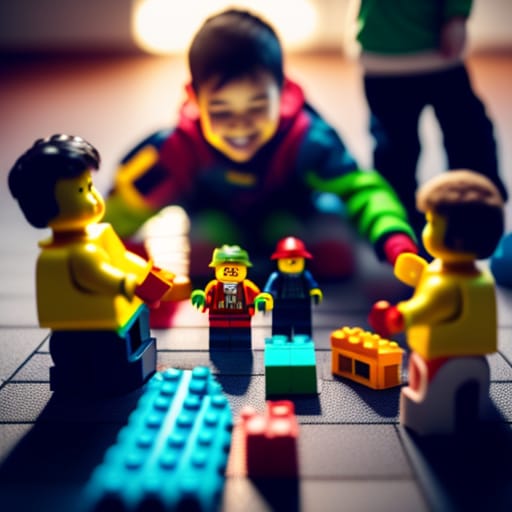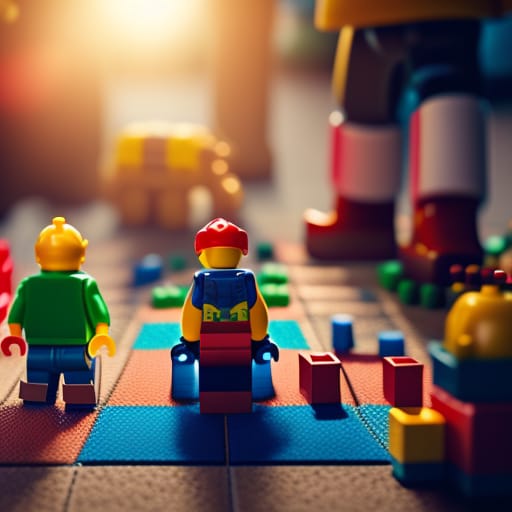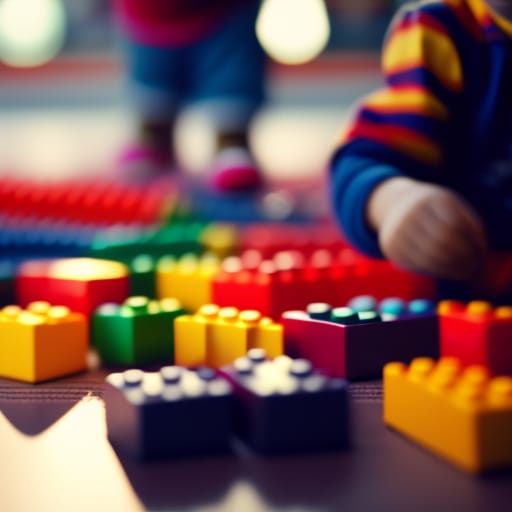Building bricks toys like Lego have captivated children and adults alike for generations. These colorful interlocking plastic bricks inspire creativity, imagination, and engineering skills. Read on to learn all about the fascinating world of building bricks toys!

Introduction to Building Bricks Toys
Building bricks toys refer to plastic construction toys that allow users to create models of buildings, vehicles, and more by interlocking the modular parts.
Definition and History
The classic building bricks toy is Lego, which was invented in Denmark in 1949 by carpenter Ole Kirk Christiansen. The name Lego comes from the Danish phrase “leg godt” meaning “play well”. The original Lego bricks were made of wood but in 1958 the iconic plastic Lego bricks were launched and revolutionized the toy industry.
Over the decades Lego has evolved with new bricks, minifigures, and licensing deals for movie and TV franchises like Star Wars. Numerous competitor brands have also emerged over the years offering their own take on interlocking plastic bricks for construction play.
Importance in Child Development
Building bricks toys provide a range of developmental benefits for children including:
- Enhancing motor skills and hand-eye coordination
- Sparking creativity and imagination
- Developing spatial thinking and problem solving skills
- Promoting engineering and architecture concepts
- Encouraging collaboration when building together
With themes ranging from cityscapes to outer space, building bricks offer endless possibilities for open-ended constructive play.
Patent and Innovation in Building Bricks Toys
The popularity of building bricks stems in large part from key patents and constant innovation that has improved the flexible modular systems and expanded possible creations over the years.
Overview of Patented Designs
The iconic 2×4 Lego brick design was patented by Lego founder Ole Kirk Christiansen in 1958. This brilliant studs-and-tubes coupling system allowed the bricks to interlock securely in different directions.
In 1989, K’Nex was launched with a patented connector system involving rods and connectors to enable movement and mechanisms.
Magna-Tiles created magnetic building tiles based on geometric principles patented in 1993. This allowed for new design possibilities like building 3D structures.
Innovations in Construction Systems
Key innovations that have improved the construction potential of building bricks include:
- Minifigures – The 1978 addition of poseable Lego minifigures enabled more imaginative play possibilities.
- Licensed Themes – Lego licensing major entertainment properties like Star Wars boosted creative building options.
- Gear Pieces – Specialized gear, wheel, and axle elements enabled moving vehicle models.
- App Integration – Some brands now have integrated digital apps to enhance the experience.
Interactive Game Features
Building bricks have also incorporated interactive play elements, sensors, and digital games in products such as:
- Lego Mindstorms – Programmable robotics kits.
- Hidden Side – Lego sets with augmented reality app integration.
- Mario sets – Lego Super Mario sets that have interactive character figures.
This allows users to build their physical models then enhance imaginative play with a digital experience.
Educational Use of Building Bricks
With their engaging and developmentally enriching qualities, building bricks are widely used in educational settings, especially for younger students.
Incorporating Building Bricks in Key Stage 1
Building bricks are well-suited to Key Stage 1 education for 5-7 year olds in the UK. Their flexible creativity aligns with the EYFS goals of imagination and problem solving.
Teachers utilize building bricks across subjects from math and science to reading and writing exercises. Students also benefit from the collaboration involved in building together.hey master foundational academic abilities with building bricks.
Marketing and Branding Building Bricks Toys
Building brick companies rely extensively on marketing and brand management to make their particular products appeal to consumers in this competitive toy industry.
Branding Building Bricks
Iconic brands like Lego demonstrate the power of branding for building bricks:
- Bright logo and packaging creates instant recognition.
- Advertisements highlight imaginative play possibilities.
- Collaboration with entertainment franchises like Star Wars expands appeal.
This branding strategy establishes Lego as the premier building brick option worth a premium price.
Marketing Tactics
Common marketing tactics in the building bricks industry include:
- Product themes – Themes based on kids’ interests like Harry Potter helps drive sales.
- YouTube videos – Demo videos showcasing building kits attract views and purchases.
- Competitions – Contests for builders engage brand fans.
Impact on Industry
Effective branding and marketing provides an advantage in the crowded building bricks space by:
- Establishing brand loyalty at a young age.
- Continually attracting new generations of builders.
- Defending shelf space at retailers against competitors.
- Licensing desirable entertainment properties early.
As a result of these marketing strengths, Lego maintains a dominant position as the #1 building brick brand worldwide.
Environmental Impact of Building Bricks Toys
While beloved by children, the mass production and waste of plastic building bricks raises environmental concerns. However, steps are being taken to improve sustainability.
Materials Used
The vast majority of building bricks are made from acrylonitrile butadiene styrene (ABS), a common rigid plastic. Some brands offer plant-based polyethylene bricks as eco-friendly options.
Sustainable Production
Some brands are implementing changes to produce bricks more sustainably:
- Lego aims to have sustainably sourced plastic bricks by 2030.
- Magna-Tiles uses recycled PET plastic from water bottles in their manufacturing.
- Green Toys creates bricks from recycled milk jugs.
Disposal Considerations
Proper disposal is important since plastic bricks are not widely recyclable. Some recommendations include:
- Donating old bricks so others can still enjoy them.
- Repurposing bricks for craft projects.
- Recycling through specialty programs that accept bulk plastic waste.
With some brands committed to sustainability and consumer recycling efforts, the future environmental impact of building bricks toys looks greener.

Technological Integration in Building Bricks
Technology is increasingly being incorporated into building bricks toys to enhance the experience with interactive play possibilities.
Integrated Technology Features
Some examples of tech integration in building bricks:
- Robotics – Programmable motors and sensors like in Lego Mindstorms sets allow users to build then program robots, vehicles, and more.
- Augmented reality – Scanning a built Lego Hidden Side model with an app makes it come to life on screen with digital interactions and games.
- Coding – Bricks with integrated tilt sensors can sync to apps teaching coding skills.
Interactive Play Benefits
Integrating technology in building bricks provides engaging new ways to play including:
- Bringing models to life digitally.
- Controlling builds electronically.
- Learning coding and robotics skills.
- Adding game elements and quests.
Future Possibilities
The future of tech-enhanced building bricks could include innovations like:
- Voice command recognition for controlling builds.
- Virtual and augmented reality immersive experiences.
- Artificial intelligence features responding to build designs.
- 3D printing integration to customize and expand pieces.
Building bricks toys will continue advancing hand-in-hand with cutting edge technology.
Cultural Significance of Building Bricks
Beloved by generations, building bricks like Lego have become ingrained in culture with a diverse community of fans worldwide.
Pop Culture Appearances
Building bricks frequently appear in pop culture like:
- The Lego Movie, a 2014 animated film.
- Lego Masters TV competition shows.
- Art sculptures built from Lego bricks.
- Lego video games.
Community Engagement
Brands engage their loyal adult fans worldwide:
- Lego hosts Brick Conventions where fans gather to display epic builds.
- Online builder communities share tips and showcase creations.
- Competitions like Lego Ideas allow users to submit builds with the chance to become official sets.
Cultural Impacts
The cultural influence of building bricks includes:
- Passionate collector culture willing to spend heavily on rare kits.
- Artists embracing bricks as a creative medium for sculpture and pixel art.
- Lego user groups forming worldwide to meet fellow building fans locally.
For generations of fans, building bricks are more than just a toy but rather a creative outlet and community.
Safety and Regulations for Building Bricks
While generally safe, some hazards do exist with building bricks, especially for younger kids. Mandatory regulations help ensure toy safety.
Potential Safety Issues
When using building bricks, be aware of risks like:
- Choking hazards from small pieces for ages under 3.
- Sharp points and edges from some connecting elements.
- Pinch hazards when attaching bricks.
- Tripping on scattered pieces left on the floor.
Supervise closely, follow age guidance, and teach kids proper handling to minimize these issues.
Mandatory Regulations
Building bricks must meet safety regulations in major markets including:
EU Toy Safety Standards
- EN 71 testing for flammability, chemicals, and more.
U.S. CPSC Regulations
- Phthalates and lead content restrictions.
- CPSC 16 CFR 1500 physical and mechanical testing.
Warning Labels
Warning labels guide proper use like:
- Choking hazard warnings.
- Age grading for who sets are appropriate for.
- Reminders for parental supervision.
Following all safety information protects children and encourages building fun.
Cognitive Benefits of Building Bricks
Beyond just being fun toys, building bricks provide proven developmental and educational benefits for kids that make them ideal educational aids.
Cognitive Development
Building with interlocking bricks promotes cognitive growth by:
- Improving spatial thinking as children visualize and construct 3D forms.
- Advancing hand-eye coordination as they precisely manipulate small pieces.
- Enhancing problem solving skills through creative building challenges.
- Supporting STEM education principles like engineering.
Imagination and Creativity
Open-ended play with building bricks boosts imagination and creativity through:
- Storytelling adventures with minifigures and models.
- Inventing new structures and designs.
- Customizing builds by combining pieces in new ways.
Therapeutic Applications
For some children, the repetitive process of assembling bricks provides a calming, therapeutic effect. Building bricks are used in sensory integration therapy for conditions like autism.
With endless constructive play possibilities, building bricks are ideal educational aids that make learning fun and engaging.
Collecting Culture Around Building Bricks
For passionate collectors, building bricks become investments worth thousands of dollars due to nostalgia and the high resale value of rare kits.
Gender Representation in Building Bricks
While historically viewed as “toys for boys”, building bricks are becoming more inclusive with wider representation and marketing expanding their appeal to all genders.
Perception of Building Bricks as Gendered
The building and construction play patterns traditionally associated with building bricks like Lego led to them being viewed primarily as boys’ toys.
However, this stereotype excludes those who do not fit expected gender norms.
Shift Toward Gender-Neutral Marketing
Many major building brick brands now aim to market their products in more gender-neutral ways:
- Showcasing boys AND girls equally enjoying the toys in commercials and ads.
- Creating playsets based on interests appealing to all genders.
- Using inclusive colors like black and white for packaging instead of only bold primary colors.
Diverse Sets and Minifigures
Product designers are creating more diversity in minifigures and themes representing women in STEM, a wider spectrum of jobs, and more.
With these changes, modern building bricks encourage open-ended creative play for all children regardless of gender.

Global Industry Trends and Market Analysis
Building bricks remain one of the most universally popular toys with steady sales worldwide. The market continues evolving through demographic shifts and disruptive new technologies.
Global Market Size
The global building bricks market size was valued at $14.4 billion in 2020 and is projected to grow at 13% CAGR to reach $38.6 billion by 2028 according to Grand View Research.
Sales Trends
- Asia Pacific leads global sales comprising 40% market share, aided by high population growth in India and China.
- Adults are driving increasing demand, comprising 5-10% of Lego’s annual sales.
- While overall growth remains stable, sales are declining in the US and Western Europe where the markets are more saturated.
Market Shifts
Trends disrupting the status quo include:
- Rise of toy rental services allowing more variety with less waste.
- Blockchain integrations establishing digital ownership records for collectibles.
- 3D printing enabling custom one-of-a-kind building pieces.
Frequently Asked Questions
What are the most popular building bricks brands?
The most popular brands are Lego, Mega Bloks, and K’Nex. Lego is the leader in building bricks toys known for their patented studs-and-tubes interlocking system.
What safety concerns should you be aware of with building bricks?
Small pieces may present a choking hazard for children under 3. Also be mindful of pointy edges that could poke fingers. Scattered pieces can also be a tripping hazard. Follow age guidance and supervise use.
How can building bricks be used in education?
Building bricks are very versatile educational aids that align with Key Stage 1 teaching goals. Teachers use them to teach shapes, counting, colors, collaboration skills, following instructions, problem solving, and more across subjects.
What makes Lego sets valuable collectors items?
Factors like nostalgia for beloved Lego sets from the past along with limited edition sets being retired make Lego highly collectible. This causes certain kits, like Cafe Corner, Taj Mahal, and Millennium Falcon to be worth thousands today.
How are building bricks becoming more gender inclusive?
Brands are evolving the marketing and product design. This includes featuring diversity in minifigures and themes, gender-neutral packaging, and showcasing all genders enjoying the toys equally in ads.
How does branding impact the building bricks market?
Iconic branding establishes instant recognition and loyalty. Lego’s branding success through ads, licensing deals, retail partnerships gives it a substantial competitive advantage commanding a premium price.
What are future technology trends for building bricks?
Integrations with programming, robotics, augmented reality and artificial intelligence are growing, taking building bricks to exciting interactive new possibilities. Voice commands, 3D printing custom pieces, and VR/AR immersion could be future innovations.